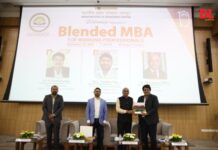E-Learning: A guidebook of Principles, Procedures and Practices
ISBN: 81-88770-04-3 This guidebook on e-learning was developed from aterials that were developed for a series of workshops on e-learning sponsored and organised by the Commonwealth Educational Media Center for Asia (CEMCA) over the past couple of years in Calicut, India and the Open University of Sri Lanka (January 2003), and in Delhi (January 2006). The content of this guidebook will help readers to systematically approach their engagement with elearning, irrespective of the educational sector or level within which they may be working. Developed by Dr. Som Naidu of the University of Melbourne, Australia on behalf of the Commonwealth Educational Media Center for Asia, New Delhi, the 100-pager guidebook is not just another textbook on elearning, but aims to clarify, simplify and demystify e-learning
E-Learning definition, scope, trends, attributes and opportunities, pedagogical designs for e-learning, assessment, feedback, e-moderation, online learning management systems, digital learning objects, online learning course development models, management and implementation of e-learning, evaluating the impacts of e-learning- all these terms giving ultimately the look and framework of a text book on e-learning, in reality is a guidebook that iscusses issues related to attributes of e-learning and acts as a primer for those who seek to venture into a new field. Rather it is designed to highlight the important issues, to ask the key questions and to tease the reader into independent thoughts. This reviewed and updated book originally written in 2003 has been tested for the technologies that are changing the way in which education is being designed and delivered through a training programme. Divided into nine chapters, the content of the book are set in such a way that they do not represent any particular sequence, providing much scope for backtracking and forward planning process. A comprehensive reference list on the subject is also provided, which is quite useful for further reading on the subject. Aside it also includes a glossary of commonly used terms on the subject. Apart from the valuable resources the book provides, one interesting feature it shows is the opportunity it provides readers to “tell us a story” about their experiences in relation to the issue or subject under discussion.
Telling a story requires readers to pause, slow down, reflect, learn, access and share their experiences or connect in a meaningful way with others. These are opportunities designed to remind readers of relevant experiences, which will enable them to reflect upon their experiences. Reflections, Points to remember and Tell us a story, going as bottom lines of each chapter and defining the goals at the start of the chapters increase the interest level of the readers significantly and along with the content enable one to make sense of new information, and in turn enables to expand the knowledgebase. The author of the guidebook, an Associate Professor in Educational Technology at the University of Melbourne, Australia is an award winning researcher and practitioner in online education who has been published extensively. The book is published on behalf of the Commonwealth Educational Media Centre for Asia by the director, CEMCA, Dr Usha V. Reddi. The book, as the publisher entions is neither a definitive publication nor a treatise on e-learning. It is designed to highlight important issues, to ask the key questions and to tease the reader into independent thought so that decisions are based on sound judgment rather than wishful thinking
























